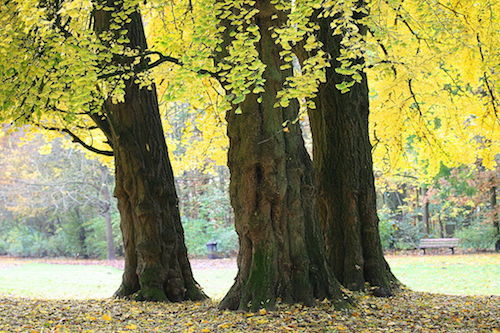 Evolution
Evolution
What Do “Living Fossils” Mean for Evolution?

While some Darwin-critics make a big deal about so-called “living fossils,” I’ve never discussed them much because it’s never been entirely clear to me what they show, whether for or against neo-Darwinian evolution. Living fossils are of course organisms that have not changed at all over long periods of time. In some cases, such as the horseshoe crab, the coelacanth, or the ginkgo tree (pictured above), these species seem to have remained virtually the same for hundreds of millions of years.
A new article in American Scientist, “The Evolutionary Truth About Living Fossils,” explores the subject, and notes that “The term living fossil has been used since Darwin coined it.” It then attacks the use of living fossils by “creationists”:
Unfortunately, creationists bent on denying the factual basis of evolution have increasingly misappropriated the term living fossil. In the Atlas of Creation, which pairs photographs of living fossils with similar ancient fossils, Turkish author and Islamic creationist Harun Yahya erroneously argues that “Darwinists are desperate when confronted by these fossils, for they prove that the evolution process has never existed.” Entry of “living fossil” into Internet search engines yields a preponderance of creationist websites, despite the fact that these species neither disprove nor provide any evidence counter to our understanding of evolution, which remains the cornerstone of biological science. There are no “unevolved” species, no reanimated fossils that have literally come back to life, and no living organisms that are truly identical to extinct species known in the fossil record.
Some of these counterpoints may be reasonable, and I certainly wouldn’t endorse Harun Yahya’s bizarre book. But the article in American Scientist misses the fact that whenever we see in the fossil record an organism that looks virtually identical to a living species, that’s also completely consistent with the hypothesis that “this species has not evolved.” So while it’s correct to for the authors say “we must not expect that all aspects of coelacanth or horseshoe crab biology have existed unchanged for hundreds of millions of years,” it’s equally if not more correct to respond that we must not assume that they have changed either (aside from, perhaps, neutral mutations). After all, the hard evidence which we have suggests they haven’t changed.
So again, what do living fossils tell us? The article offers various ideas, but at one point notes that living fossils show us that natural selection is a preservative and conserving force, rather than a creative one:
Most major animal body plans have existed unchanged since the Cambrian explosion 530 million years ago. … Evolutionary biologist George Williams keenly noted in his 1997 book The Pony Fish’s Glow that “adaptationist stories are not about evolution so much as about its absence.” Such stories focus less on how various features arise than on why they are maintained — why they do not continue to evolve. Once the bipedal stance, big brains, and opposable thumbs of human ancestors arose, why did these features linger? Natural selection preserves features by preventing their loss. In describing this corrective, optimizing process of normalizing selection, Williams wrote, “What natural selection mainly does is to cull departures from the currently optimum development.” Aristotle’s descriptions of wild animals and plants, written 2,500 years ago, are still accurate for their descendants today, mainly because natural selection has prevented their evolution.
(Alexander J. Werth and William A. Shear, “The Evolutionary Truth About Living Fossils,” American Scientist, Vol. 102:434-443 (2014).)
All that’s fine and good, but it leaves unanswered questions about how animal body plans, humanity’s big brains and opposable thumbs, or a myriad of other biological features arose in the first place. Perhaps living fossils serve to remind us that evolutionary biology lacks a theory of the generative.
The authors of the article don’t agree. In fact, the piece closes by claiming that everything everywhere at every moment of time in all cases provides evidence for evolution — including living fossils:
Despite their apparent resistance to chance, living fossils, like all organisms extant and extinct, serve as proof that evolution continues unabated as the driving force behind the tremendous diversity of life on Earth, in the past as well as in the present.
You just read nothing. I mean, nothing.
Everything proves evolution– even the absence of evolution! Such talk would be funny if it weren’t being offered in dead seriousness. It’s also a reminder of the unhealthy state of evolutionary biology. Scientists feel pressured to pretend that anything and everything — including species that show no evidence of change at all — confirms the Darwinian thesis, thus demonstrating their neo-Darwinian bona fides even while discussing an awkward topic like living fossils.
I wonder, if present-day organisms that appear identical to fossils that are hundreds of millions of years old “serve as proof” that evolutionary mechanisms created “the tremendous diversity of life on Earth,” then what might serve as disproof? Apart from obvious absurdities like the infamous Precambrian rabbit, the answer appears to be: nothing.
Image: Ginkgo biloba trees, Morlanwelz-Mariemont Park, Belgium/Wikipedia.
